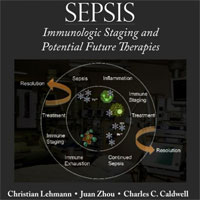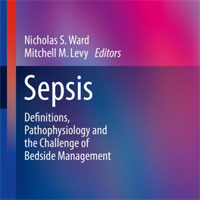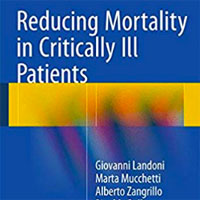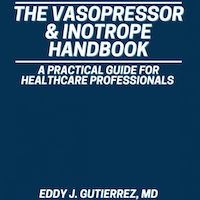Tag: septic shock
Hydrocortisone plus Fludrocortisone for Adults with Septic Shock
The use of steroids in critically ill patients continues to be controversial. Whilst there are signals for improved cardiovascular parameters, this did not translate to clear mortality benefits. The most recent of these trials... read more
Do phenylephrine and epinephrine require central access?
Until recently I believed that prolonged vasopressor administration requires a central line, to avoid extravasation. I lumped together all vasopressors, treating them all as equal. I used the occurrence of an extravasation... read more
Silent Space
Exhausted at the end of a busy week on service in the intensive care unit (ICU), the fellow and I are on our way to the conference room to debrief the week. The overhead code alarm disrupts the temporary lull in activity... read more
Intensive Care Medicine in 2050: Vasopressors in Sepsis
Vasopressors are used in sepsis when hypotension is assumed to be mainly due to a decreased arterial tone. However, the appropriate time to initiate vasopressors is not clearly defined, and fluid administration is most... read more
New World Sepsis Day Infographics
The new World Sepsis Day Infographics are now available for download, just in time for World Sepsis Day this Thursday. Please download them and feel free to use them as you see fit, on your social media channels, printed... read more
Hospital Variation in Risk-Adjusted Pediatric Sepsis Mortality
Margaret Parker, MD, MCCM, speaks with Stefanie G. Ames, MD, about the article "Hospital Variation in Risk-Adjusted Pediatric Sepsis Mortality," published in the May 2018 issue of Pediatric Critical Care Medicine. Dr. Ames... read more
Haemoglobin concentration and volume of intravenous fluids in septic shock in the ARISE trial
Haemoglobin concentration decreases during resuscitation from septic shock, and has a significant but weak association with the volume of intravenous fluids administered. Median (IQR) haemoglobin concentration at baseline... read more
It Makes No Difference – Glucocorticoids for the Treatment of Septic Shock
The administration of a continuous infusion of hydrocortisone to a general population of patients in septic shock on mechanical ventilation cannot be recommended at this time. The authors conclusion that glucocorticoids do... read more
Predicting the Requirement for RRT in Intensive Care Patients with Sepsis
Sepsis is one of the most frequent causes of acute kidney injury (AKI) in critically ill patients, with initial organ impairment often followed by dysfunction in other systems. Renal dysfunction may therefore represent one... read more
Dying as a Pathway to Death in Sepsis
Mortality from sepsis remains high, with at least 270,000 deaths annually in the United States and more than 5 million deaths worldwide. Despite increasing understanding of the pathophysiology of sepsis, outside of targeted... read more
Duration of hypotension before initiation of effective antimicrobial therapy is the critical determinant of survival in human septic shock
Effective antimicrobial administration within the first hour of documented hypotension was associated with increased survival to hospital discharge in adult patients with septic shock. Despite a progressive increase in mortality... read more
The Effect of Alcohol Consumption on the Risk of ARDS
Chronic high alcohol consumption significantly increases the risk of ARDS. This finding suggests that patients admitted to hospital should be screened for chronic alcohol use. Seventeen observational studies (177,674 people)... read more
Association Between the New York Sepsis Care Mandate and In-Hospital Mortality for Pediatric Sepsis
In New York State following a mandate for sepsis care, completion of a sepsis bundle within 1 hour compared with not completing the 1-hour sepsis bundle within 1 hour was associated with lower risk-adjusted in-hospital mortality... read more
I Had PTSD After a Critical Illness. Apparently That’s Fairly Common
The emotional trauma of a near-death experience causes ongoing emotional and physical symptoms in one-third of ICU patients. PICS doesn't have a time limitation and can be triggered by almost anything. I was suddenly anxious... read more
MAP of 65: Target of the Past?
Septic shock is defined as sepsis with hypotension refractory to fluid challenge and requiring vasopressor support combined with an increase in arterial lactate reflecting impaired cellular energy metabolism and dysoxia.... read more
Choice of Fluid Therapy in the Initial Management of Sepsis, Severe Sepsis, and Septic Shock
Sepsis results in disruption of the endothelial glycocalyx layer and damage to the microvasculature, resulting in interstitial accumulation of fluid and subsequently edema. Fluid resuscitation is a mainstay in the initial... read more
Presenting Symptoms Independently Predict Mortality in Septic Shock
More than one third of patients with septic shock presented to the emergency department with vague symptoms that were not specific to infection. These patients had delayed antibiotic administration and higher risk of mortality... read more
Decatecholaminisation during sepsis
While necessary and life-saving in the early fight or flight reaction to any insult, prolonged adrenergic stress is detrimental and contributes to organ dysfunction. In the largest trial to date, Morelli et al. enrolled septic... read more
Hemodynamic Support of Pediatric and Neonatal Septic Shock
Margaret Parker, MD, MCCM, speaks with Joseph A. Carcillo, MD, about the article, "American College of Critical Care Medicine Clinical Practice Parameters for Hemodynamic Support of Pediatric and Neonatal Septic Shock," published... read more
In vitro comparison of the adsorption of inflammatory mediators by blood purification devices
Septic shock, a leading cause of acute kidney injury, induces release of pro-/anti-inflammatory mediators, leading to increased mortality and poor renal recovery. This is the first in vitro study directly comparing three... read more
The Relationship Between ICU Hypotension and In-hospital Mortality and Morbidity in Septic Patients
Current guidelines recommend maintaining a mean arterial pressure (MAP)≥ 65 mmHg in septic patients. However, the relationship between hypotension and major complications in septic patients remains unclear. We, therefore,... read more
Pushing Pressors in the Periphery
The mantra of the Broome Docs site is "bringing great care, out there." And today's topic goes right to the heart of that theme. It is one of my pet topics – so apologies in advance if the rant is too long or detailed.... read more









